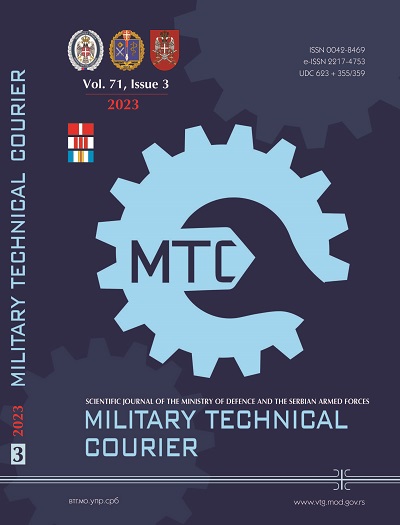Contribution to the research of oscillatory loads of sprung and unsprung masses in order to create conditions for laboratory tests of heavy motor vehicles
Abstract
Introduction/purpose: Motor vehicles are complex dynamic systems due to spatial displacements, changes in the characteristics of components during their lifetime, a large number of influences and disturbances, the appearance of backlash, friction, hysteresis, etc. The aforementioned dynamic phenomena, especially vibrations, cause driver and passenger fatigue, reduce the lifetime of the vehicle and its systems, etc.
Methods: In general, the movement of vehicles is carried out on uneven roads and curvilinear paths in the road. Not only do oscillatory movements cause material fatigue of vehicle parts, but they also have a negative effect on people's health. That is why special attention must be paid to the coordination of the mutual movement of the subsystems, and in particular, the vehicle suspension system, even at the stage of the motor vehicle design. For these purposes, theoretical, experimental or combined methods can be used. Therefore, it is very useful to have the experimental results of the oscillations of the vehicle subsystem in operating conditions, so the aim of this work was to use the movement of the 4x4 drive FAP 1118 vehicle in operating conditions (due to higher speeds - in road conditions) to define the conditions for testing oscillatory loads in laboratory conditions.
Results:This is made possible by registering and identifying statistical parameters of registered quantities.
Conclusion: Based on the measured data, the research can be programmed on shakers in laboratory conditions, and, at the same time, the size to be reproduced can be chosen as well.
References
Abe, M. 2009. Vehicle Handling Dynamics: Theory and Application, 1st Edition. Oxford, UK: Butterworth-Heinemann. ISBN: 9780080961811.
Bendat, J.S. & Piersol, A.G. 2000. Random Data: Analysis and Measurement Procedures, 4th Edition. Hoboken, NJ: John Wiley & Sons. ISBN: 978-0-470-24877-5.
Cox, D.R. & Reid, N. 2000. The Theory of the Design of Experiments. Chapman & Hall/CRC. ISBN: 1-58488-195-X.
Demić, M. 1997. Optimizacija oscilatornih sistema motornih vozila. Kragujevac, Serbia: Mašinski fakultet (in Serbian). ISBN: 86-81745-40-9.
Demić, M. & Diligenski, Đ. 2003. The Road Surface Profile Investigation Perspective. In: The 30' Session - „Modern technologies in XXI Century”, Bucharest, Romania, pp.35-42.
Demić, M. 2006. Dinamičke pobude automobila. Belgrade, Serbia: Institut za nuklearne nauke „Vinča”, Centra za motore i vozila (in Serbian). ISBN: 86-7306-077-X.
Demić, M. 2008. Kibernetski sistem: čovek - vozilo - okruženje. Kragujevac, Serbia: Centar za naučna istraživanja SANU i Univerziteta u Kragujevcu (in Serbian). ISBN: 978-86-81037-21-8.
Demić, M., Đurić, A., Grkić, A., Drakulić, M. & Muždeka, S. 2022. A contribution to investigation of oscillatory loads of driving axles in order to create conditions for laboratory tests of trucks. In: IOP Conference Series: Materials Science and Engineering, Volume 1271, IX International Congress Motor Vehicles and Motors (MVM 2022), Kragujevac, Serbia, October 13-14. Available at: https://doi.org/10.1088/1757-899X/1271/1/012001.
Demić, M., Toljski, V. & Spentzas, K. 2001. A contribution to investigation of the tire nonuniformity influence to vehicle steering system vibration. Vojnotehnički glasnik/Military Technical Courier, 49(3), pp.293-300 (in Serbian). Available at: https://doi.org/10.5937/vojtehg0103293D.
Ellis, J.R. 1969. Vehicle Dynamics. Business Books. ISBN 13: 9780220992026.
Fiala, E. 2006. Mensch und Fahrzeug: Fahrzeugführung und sanfte Technik, ATZ/MTZ Fachbuch. Vieweg+Teubner Verlag (in German). ISBN-13: 978-3834800169.
Genta, A. 1997. Motor Vehicle Dynamics: Modeling and Simulation (Advances in Mathematics for Applied Sciences). Singapore: World Scientific Publishing Company. ISBN-13: 978-9810229115.
Gillespie, T.D. 1992. Fundamentals of Vehicle Dynamics. Warrendale, PA, USA: SAE International. Available at: https://doi.org/10.4271/R-114.
Grkić, A.R. 2015. Energy potential of friction brake. Ph.D. thesis. Belgrade, Serbia: University of Belgrade, Faculty of Mechanical Engineering (in Serbian) [online]. Available at: https://nardus.mpn.gov.rs/handle/123456789/5278 [Accessed: 02 March 2023].
Hachaturov, A.A. 1976. Dinamika sistemy doroga - shina - avtomobil' – voditel'. Moscow: Mashinostroenie (in Rusian). (In the original: Хачатуров, А.А. 1976. Динамика системы дорога - шина - автомобиль – водитель. Москва: Машиностроение).
-ISO. 1995. ISO 8608:1995 Mechanical vibration — Road surface profiles — Reporting of measured data [online]. Available at: https://www.iso.org/standard/15913.html [Accessed: 03 March 2023].
Jovanović, S. & Đurić, A. 2009. Analysis of risks from crew exposure to vibrations in military transport. Vojnotehnički glasnik/Military Technical Courier, 57(4), pp.93-107 (in Serbian). Available at: https://doi.org/10.5937/vojtehg0904093J.
Milliken, W.F. & Milliken, D.L. 1994. Race Car Vehicle Dynamics. Warrendale, PA, USA: SAE International. ISBN: 978-1-56091-526-3.
Mitschke, M. 1972. Dynamik der Kraftfahrzeuge. Berlin, Heidelberg: Springer. Available at: https://doi.org/10.1007/978-3-662-11585-5.
Muždeka, S. 2008. Predviđanje funkcionalnih karakteristika planetarnih prenosnika snage. Ph.D. thesis. Belgrade, Serbia: University of Belgrade, Faculty of Mechanical Engineering (in Serbian).
O`Connor, P.D.T & Kleyner, A. 2012. Practical Reliability Engineering, Fifth Edition. Hoboken, NJ: John Wiley & Sons, Ltd. ISBN: 9780470979815.
Rajamani, R. 2006. Vehicle Dynamics and Control. New York, NY, USA: Springer. ISBN: 9780387263960.
Simić, D. 1980. Dinamika motornih vozila. Belgrade, Serbia: Naučna knjiga (in Serbian).
Vukadinović, S. 1973. Elementi teorije verovatnoće i statistike. Belgrade, Serbia: Privredni pregled (in Serbian).
Copyright (c) 2023 Miroslav D. Demić, Aleksandar S. Đurić, Aleksandar R. Grkić, Momir M. Drakulić, Slavko Muždeka

This work is licensed under a Creative Commons Attribution 4.0 International License.
Proposed Creative Commons Copyright Notices
Proposed Policy for Military Technical Courier (Journals That Offer Open Access)
Authors who publish with this journal agree to the following terms:
Authors retain copyright and grant the journal right of first publication with the work simultaneously licensed under a Creative Commons Attribution License that allows others to share the work with an acknowledgement of the work's authorship and initial publication in this journal.
- Authors are able to enter into separate, additional contractual arrangements for the non-exclusive distribution of the journal's published version of the work (e.g., post it to an institutional repository or publish it in a book), with an acknowledgement of its initial publication in this journal.
- Authors are permitted and encouraged to post their work online (e.g., in institutional repositories or on their website) prior to and during the submission process, as it can lead to productive exchanges, as well as earlier and greater citation of published work (See The Effect of Open Access).

